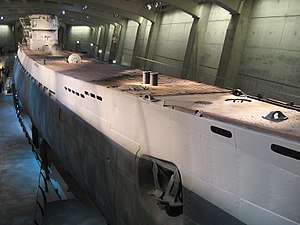German submarine U-127 (1941)
German submarine U-127 was a Type IXC U-boat of Nazi Germany's Kriegsmarine during World War II. She was laid down at the DeSchiMAG AG Weser yard in Bremen as yard number 909 on 20 June 1940, launched on 1 February 1941 and commissioned on 24 April under the command of Korvettenkapitän Bruno Hansmann.
 U-505, a typical Type IXC boat | |
| History | |
|---|---|
| Name: | U-127 |
| Ordered: | 7 August 1939 |
| Builder: | DeSchiMAG AG Weser in Bremen |
| Laid down: | 20 June 1940 |
| Launched: | 1 February 1941 |
| Commissioned: | 24 April 1941 |
| Fate: | Sunk, 15 December 1941 by an Australian warship[1] |
| General characteristics | |
| Class and type: | Type IXC submarine |
| Displacement: |
|
| Length: |
|
| Beam: |
|
| Height: | 9.60 m (31 ft 6 in) |
| Draught: | 4.70 m (15 ft 5 in) |
| Installed power: |
|
| Propulsion: |
|
| Range: |
|
| Test depth: | 230 m (750 ft) |
| Complement: | 4 officers, 44 enlisted |
| Armament: |
|
| Service record[2] | |
| Part of: |
|
| Commanders: |
|
| Operations: |
|
| Victories: | None |
Design
German Type IXC submarines were slightly larger than the original Type IXBs. U-127 had a displacement of 1,120 tonnes (1,100 long tons) when at the surface and 1,232 tonnes (1,213 long tons) while submerged.[3] The U-boat had a total length of 76.76 m (251 ft 10 in), a pressure hull length of 58.75 m (192 ft 9 in), a beam of 6.76 m (22 ft 2 in), a height of 9.60 m (31 ft 6 in), and a draught of 4.70 m (15 ft 5 in). The submarine was powered by two MAN M 9 V 40/46 supercharged four-stroke, nine-cylinder diesel engines producing a total of 4,400 metric horsepower (3,240 kW; 4,340 shp) for use while surfaced, two Siemens-Schuckert 2 GU 345/34 double-acting electric motors producing a total of 1,000 metric horsepower (740 kW; 990 shp) for use while submerged. She had two shafts and two 1.92 m (6 ft) propellers. The boat was capable of operating at depths of up to 230 metres (750 ft).[3]
The submarine had a maximum surface speed of 18.3 knots (33.9 km/h; 21.1 mph) and a maximum submerged speed of 7.3 knots (13.5 km/h; 8.4 mph).[3] When submerged, the boat could operate for 63 nautical miles (117 km; 72 mi) at 4 knots (7.4 km/h; 4.6 mph); when surfaced, she could travel 13,450 nautical miles (24,910 km; 15,480 mi) at 10 knots (19 km/h; 12 mph). U-127 was fitted with six 53.3 cm (21 in) torpedo tubes (four fitted at the bow and two at the stern), 22 torpedoes, one 10.5 cm (4.13 in) SK C/32 naval gun, 180 rounds, and a 3.7 cm (1.5 in) SK C/30 as well as a 2 cm (0.79 in) C/30 anti-aircraft gun. The boat had a complement of forty-eight.[3]
Service history
She began her brief service career training with the 2nd U-boat Flotilla and was declared operational with the same organization on 1 November 1941.
Patrol and loss
U-127 departed Kiel on 29 November, crossed the North Sea and entered the Atlantic Ocean via the 'gap' between the Faroe and Shetland Islands.
She was sunk west of Gibraltar on 15 December by the Australian destroyer HMAS Nestor. Out of a crew of 51, there were no survivors.
References
- Kemp 1999, p. 75.
- Helgason, Guðmundur. "The Type IXC boat U-127". German U-boats of WWII - uboat.net. Retrieved 16 October 2014.
- Gröner 1991, p. 68.
Bibliography
- Busch, Rainer; Röll, Hans-Joachim (1999). German U-boat commanders of World War II : a biographical dictionary. Translated by Brooks, Geoffrey. London, Annapolis, Md: Greenhill Books, Naval Institute Press. ISBN 1-55750-186-6.CS1 maint: ref=harv (link)
- Busch, Rainer; Röll, Hans-Joachim (1999). Deutsche U-Boot-Verluste von September 1939 bis Mai 1945 [German U-boat losses from September 1939 to May 1945]. Der U-Boot-Krieg (in German). IV. Hamburg, Berlin, Bonn: Mittler. ISBN 3-8132-0514-2.CS1 maint: ref=harv (link)
- Gröner, Erich; Jung, Dieter; Maass, Martin (1991). U-boats and Mine Warfare Vessels. German Warships 1815–1945. 2. Translated by Thomas, Keith; Magowan, Rachel. London: Conway Maritime Press. ISBN 0-85177-593-4.
- Kemp, Paul (1999). U-Boats Destroyed - German Submarine Losses in the World Wars. London: Arms & Armour. ISBN 1-85409-515-3.CS1 maint: ref=harv (link)
External links
- Helgason, Guðmundur. "The Type IXC boat U-127". German U-boats of WWII - uboat.net. Retrieved 7 December 2014.
- Hofmann, Markus. "U 127". Deutsche U-Boote 1935-1945 - u-boot-archiv.de (in German). Retrieved 7 December 2014.